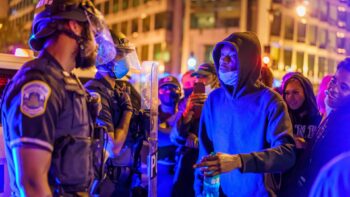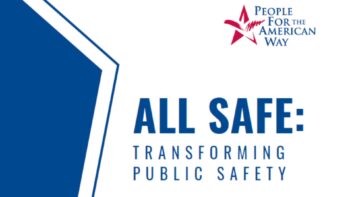
This fact sheet is part of People For the American Way’s new report All Safe: Transforming Public Safety. Here, we give an overview of one of the four prongs in our approach to reducing police violence: Recruiting well-trained public safety personnel committed to serving and protecting their communities.
Problem: Police department recruitment material can attract aggressive individuals by highlighting violent interactions with the public and displaying officers resorting to the use of force or over-aggressive, militarized policing. Psychological screenings for applicants are often not sufficient to exclude violent individuals. Also, although a higher level of officer education is associated with fewer violent encounters with the public, too few officers have attained more than a high school diploma.
Solution: Change recruitment material to focus on positive traits needed to create a community-oriented police force that is less likely to result in police violence, and enhance pre-employment screening practices including psychological testing and educational requirements.
Key Facts
- A comprehensive study analyzing the recruiting materials used by the 200 largest police departments in the United States found that, of all advertisements surveyed: 42.7% contained some display of drawn firearms; 34% depicted military-style weapons; 32% depicted officers in tactical vests; 27.7% depicted paramilitary policing units; 20.4% depicted civilians in handcuffs; 13.1% depicted active pursuits; and 4.4% contained depictions of military-style vehicles.
- The recruiting materials used by many departments in the Key Metro Areas [where most Black Americans live] are replete with action sequences, suspect chases, and drawn weapons that look like scenes from military recruiting advertisements.
- Eliminating militaristic themes in recruiting—and replacing them with images of non-violent community policing—is a plain opportunity for departments to attract officers more interested in community engagement.
- Most major police departments administer some form of a psychological screening.
- Many larger police departments focus on screening out potentially violent traits—such as aggression and impulsiveness—but do not screen in traits such as compassion and empathy.
- The most commonly used test is the Minnesota Multiphasic Personality Inventory (MMPI)-II—a test not specifically designed for screening police officers.
- All of the tests used by police departments are designed primarily based on the reactions of White men, highlighting the need for better, more inclusive psychological screenings
- Researchers find that college-educated officers are less likely to use force.
- In a study analyzing police interactions in Indianapolis, Indiana and St. Petersburg, Florida, about 56% of encounters involving officers with at least some college resulted in force, whereas nearly 68% of encounters involving officers with no college experience involved force.
- In a 2017 survey of 958 police departments, 81.5 percent of agencies require only a high school diploma, 30.2 percent of officers had 4-year degrees, and 51.8 percent had 2-year degrees.
- Police forces can use financial incentives to encourage officers to obtain degrees; many departments in the Key Metro Areas offer incentives, but details are not always apparent.
Learn More About Transforming Public Safety
|
|
|
|


